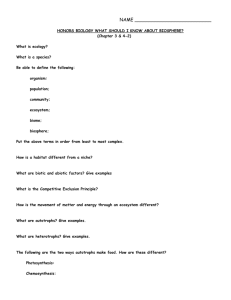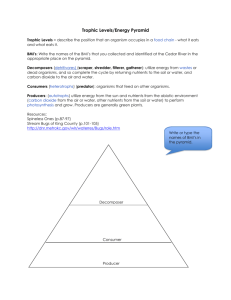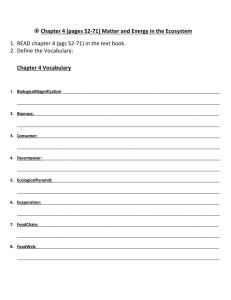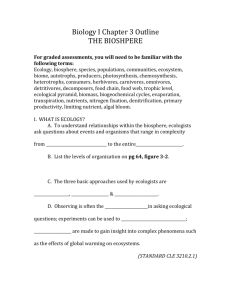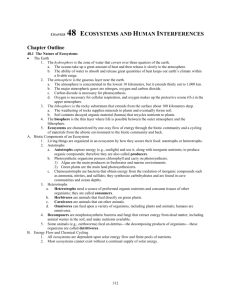47.4 Notes
advertisement
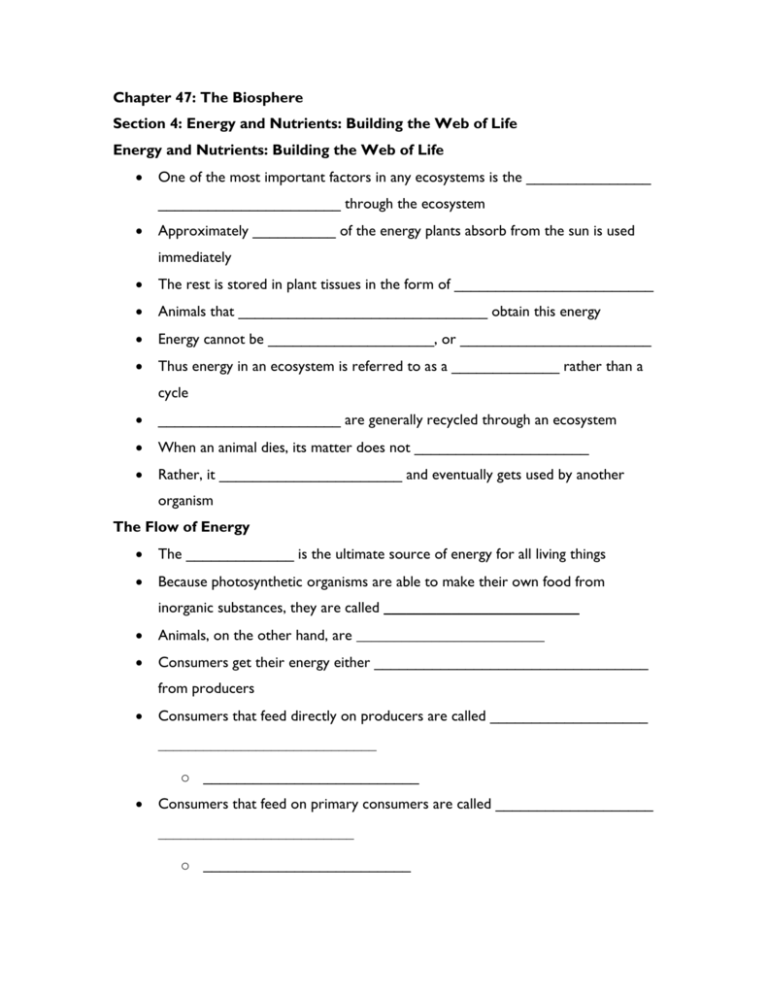
Chapter 47: The Biosphere Section 4: Energy and Nutrients: Building the Web of Life Energy and Nutrients: Building the Web of Life One of the most important factors in any ecosystems is the _______________ ______________________ through the ecosystem Approximately __________ of the energy plants absorb from the sun is used immediately The rest is stored in plant tissues in the form of ________________________ Animals that ______________________________ obtain this energy Energy cannot be ____________________, or _______________________ Thus energy in an ecosystem is referred to as a _____________ rather than a cycle ______________________ are generally recycled through an ecosystem When an animal dies, its matter does not _____________________ Rather, it ______________________ and eventually gets used by another organism The Flow of Energy The _____________ is the ultimate source of energy for all living things Because photosynthetic organisms are able to make their own food from inorganic substances, they are called __________________________ Animals, on the other hand, are _________________________ Consumers get their energy either _________________________________ from producers Consumers that feed directly on producers are called ___________________ _____________________________ o __________________________ Consumers that feed on primary consumers are called ___________________ __________________________ o _________________________ Energy flows through an ecosystem from the sun to producers and then to consumers When plants and animals in an ecosystem die, their remains do not build up because of the presence of ____________________________ Decomposers are organisms that obtain their energy from ________________ _________________________________ Each step in this series of organisms eating other organisms is called a __________________, or ____________________ level At each higher trophic level, less and less of the energy originally captured by the producers is available Approximately ___________ of the energy at one trophic level can be used by animals at the next trophic level At each successive trophic level, _________________________ is available to an organism Ecological Pyramids Ecologists use ___________________________________ to represent the energy relationships among trophic levels There are three types of ecological pyramids o _______________________________ o _______________________________ o _______________________________ Pyramid of Energy A pyramid of energy shows the total amount of ________________________ _________________ at each successive level Pyramid of Biomass The trophic levels of an ecosystem can also be represented by a pyramid of biomass, which shows the ________________________________________ at each level Pyramid of Numbers Relationships among trophic levels may also be represented by a pyramid of numbers A pyramid of numbers illustrates the ________________________________ ________________________ at each level Biogeochemical Cycles Although energy moves in a one-way direction through an ecosystem, nutrients are recycled All organisms require certain essential nutrients in order to _____________ As members of each trophic level eat members of the level beneath them, they acquire the complex organic molecules and elements they need in addition to energy Nutrients move through the biosphere in a series of physical and biological processes called ________________________________, or nutrient, ________________ The Water Cycle The movement of water from the atmosphere to the Earth and back to the atmosphere is called the ______________________________ The water cycle consists of an alternation of __________________________ and ________________________ Water molecules enter the air by evaporation from the ocean and other bodies of water In the air, water molecules condense and then return to the Earth in the form of _________________________ On land, most of the rainwater runs along the surface of the ground until it enters a river or stream that carries it to a larger body of water Some water sinks into the ground and is called ________________________ The upper surface of groundwater is known as the ______________________ The Nitrogen Cycle All organisms require nitrogen to __________________________________ The movement of nitrogen through the biosphere is called the _____________________________________ However, most of the nitrogen cannot be directly used by living things It must be _______________________ into other forms Certain bacteria that live on roots of plants change free nitrogen in the atmosphere into nitrogen compounds that can be used by living things o ______________________________________ Once the nitrogen compounds are available, plants use them to make plant proteins Animals then eat the plants and use the proteins to make animal proteins When the plants and animals die, the nitrogen compounds ________________ ________________________________ Eventually other bacteria in the soil break down these nitrogen compounds into free nitrogen in a process called _________________________________ These bacteria are called denitrifying bacteria Through the process of denitrification, free nitrogen is returned to the atmosphere The Carbon and Oxygen Cycles The process by which carbon is moved through the environment is called the ______________________________ During photosynthesis, green plants and algae use carbon dioxide from the atmosphere to form __________________ Consumers and decomposers use glucose is respiration, during which they produce carbon dioxide Carbon dioxide is then released into the atmosphere, completing the carbon cycle The movement of oxygen through the environment is called the ________________________________ During photosynthesis, water molecules are split, releasing oxygen into the atmosphere The oxygen is used by most organisms for respiration During respiration, ___________________________________ The water is absorbed by plants, and the cycle begins again Nutrient Limitation The rate at which producers can capture energy and use it to produce living tissue is controlled be several factors, one of which is the amount of ___________________________________ If a nutrient is in short supply – thus limiting an organism’s growth – it is called a _________________________________ Feeding Relationships The simplest feeding relationship is a _______________________________ In one food chain, a big fish eats little fish that eat tiny fish that eat plankton Nature is almost never that simple Instead of using a food chain, which only shows one feeding level, ecologists use ___________________________ Food webs have many ___________________________________
